Introduction to Homeschool Preschool Curriculum
Choosing a **preschool curriculum for homeschool** is a pivotal decision for parents planning to educate their young children at home.
The choice involves understanding the unique educational needs of preschoolers and aligning them with suitable resources and teaching methods.
At Thomas Keith Independent School, we emphasise that a well-structured **preschool curriculum for homeschool** should not only focus on academic learning but also nurture essential life skills and emotional intelligence.
The **preschool curriculum for homeschool** is a foundational piece in a child’s educational journey, influencing how homeschool programs for preschoolers are structured and delivered.
Parents must first evaluate the educational goals they wish to achieve through their chosen curriculum, taking into consideration the child’s learning style, interests, and developmental stage.
A meticulously crafted **preschool curriculum for homeschool** combines both the rigidity of formal education and the flexibility to adapt teaching to a child’s individual pace, focusing on the overall well-being and holistic development of the child.
Incorporating aspects of play, exploration, and social interaction is crucial, ensuring that the curriculum covers fundamental areas such as language skills, basic mathematics, and introductory science.
Parents should integrate outdoor activities and creative arts into the **preschool curriculum for homeschool** to foster an environment of curiosity and enthusiasm toward learning.
Every child’s homeschooling experience is unique; thus, the **preschool curriculum for homeschool** should be a dynamic framework that evolves with the child’s growth, piquing their curiosity and setting the stage for lifelong learning.
In summary, a comprehensive **preschool curriculum for homeschool** provides a versatile and child-centred learning environment that equips preschoolers with the skills needed to thrive both academically and personally.
Understanding the Basics of Preschool Learning
In the realm of early education, the preschool curriculum for homeschool plays a pivotal role in a child’s developmental journey.
At Thomas Keith Independent School, we recognise the cruciality of establishing a solid foundation during these formative years.
Preschool learning sets the stage for future academic success, and the homeschool curriculum should be meticulously crafted to encompass various key aspects of early education.
The preschool curriculum for homeschool must incorporate language development, numeracy skills, and social interaction to offer a holistic educational experience.
Language development is significant for preschoolers as it forms the basis for reading and communication skills.
Incorporating activities such as storytelling, letter recognition, and vocabulary expansion into the homeschool curriculum can enhance a child’s linguistic capabilities.
Numeracy, another cornerstone of the preschool curriculum, involves introducing simple mathematical concepts through engaging activities.
Counting objects, recognising shapes, and pattern identification are effective methods to foster mathematical understanding in preschoolers.
Social interaction is equally paramount, particularly within a homeschool setting, where opportunities for peer engagement might be limited.
Structured playdates or group activities can facilitate social skills and ensure a well-rounded learning experience for children in a home school program.
The integration of arts and crafts, music, and physical education in the homeschool curriculum adds a creative and dynamic dimension to preschool learning.
These activities not only support motor skill development but also encourage creativity and self-expression, essential attributes for young learners.
Creating a stimulating and nurturing environment at home is vital for the preschool curriculum to effectively cater to the needs of every child.
A well-structured homeschool programme should seamlessly blend educational content with play, capitalising on a child’s innate curiosity and desire to learn.
Understanding these basics equips educators and parents with the tools to deliver an enriching and comprehensive preschool curriculum for homeschool settings.
Exploring Different Preschool Curriculum Options
When considering a preschool curriculum for homeschool, parents have an array of diverse options to tailor their teaching approach to their child’s unique needs.
Each curriculum emphasises different aspects of preschool education, providing varied methodologies to foster early childhood development.
Understanding the nuances of each option can assist parents in choosing the most appropriate preschool curriculum for their homeschool setting.
In recent years, adopting a preschool curriculum for homeschool has gained traction as it offers the flexibility to align educational content with a child’s learning style.
One popular option is the Montessori approach, which centres around self-directed activity and hands-on learning.
This method encourages children to explore and understand concepts at their own pace, emphasising independence and allowing them to follow their innate curiosity.
For parents seeking a structured framework, the Charlotte Mason method offers another effective preschool curriculum for homeschool.
Characterised by a focus on literature, nature study, and the arts, this approach promotes a love of learning and integrates living ideas rather than rote memorisation.
It aims to nurture a child’s mind by exposing them to beautiful concepts and stories, making learning a more enriching experience.
Thematic or unit-based curriculums are also favoured by many homeschooling families.
These curriculums revolve around specific themes, such as animals, weather, or community helpers, integrating various subjects like language arts, science, and social studies within each theme.
This method not only reinforces a comprehensive understanding of a particular topic but also ensures that learning remains engaging for preschoolers.
For those interested in a Christian perspective, some homeschool programs for preschoolers offer faith-based curriculums.
These programmes incorporate biblical teachings alongside traditional academic content, seamlessly integrating religious education within the preschool curriculum for homeschool learners.
Additionally, online preschool curriculum platforms, such as Time4Learning, provide a more interactive experience, utilising technology to deliver a comprehensive curriculum.
These digital resources are often adaptive, offering personalised activities that cater to different learning needs and help track a child’s progress.
Ultimately, the choice of a preschool curriculum for homeschool depends on various factors, including a family’s educational philosophy, the child’s learning style, and the resources available.
Exploring these diverse curriculum options empowers parents to offer a tailored and effective homeschooling experience that lays a solid educational foundation for their preschooler.

The Charlotte Mason Approach to Preschool
The Charlotte Mason approach to the preschool curriculum for homeschool is rooted in the philosophy that children thrive in an environment that encourages exploration and engagement with the real world.
This educational method emphasises a child-led approach, where young learners are encouraged to “let them be little” while nurturing their natural curiosity.
In this context, preschoolers are introduced to various subjects through short, interactive lessons that focus on developing their attention span and cultivating a love for learning.
Incorporating the teachings of nature, art, and literature, the Charlotte Mason method uniquely combines these elements to form a comprehensive preschool curriculum for homeschool environments.
Parents who adopt this approach are encouraged to spend quality time outside with their children, engage in storytelling, and introduce rich vocabulary through read-aloud sessions.
This method values the importance of habits, particularly in nurturing attention, quality of work, and a sense of responsibility in children.
A fundamental principle of the Charlotte Mason homeschool curriculum is to foster connections with the world through first-hand experiences, creating a strong foundation for future academic success.
By adopting this approach, parents can build a preschool curriculum for homeschool settings that holistically focuses on intellectual development and emotional growth.
The integration of living ideas into everyday learning rituals helps children develop their character while instilling a lifelong love for learning.
At Thomas Keith Independent School, we support parents in navigating these unique educational philosophies by providing them with tools and resources necessary to implement a Charlotte Mason-based preschool curriculum for homeschool effectively.
The result is an education that prepares young learners for future educational endeavours while respecting their individuality and formative learning experiences.
Montessori Methods in Homeschooling
The Montessori method is an increasingly popular approach within the preschool curriculum for homeschool, particularly due to its emphasis on child-centred education.
Montessori homeschooling encourages a learning environment that promotes individuality, autonomy, and practical life skills, making it a compelling option for home school programs for preschoolers.
At its core, the Montessori approach seeks to foster a child’s natural curiosity by providing opportunities for exploration and discovery.
This is facilitated through a carefully prepared environment that includes various hands-on activities, designed to guide the child in self-directed learning.
In the Montessori method, the role of the teacher, or parent in a homeschool setting, is to act as a guide rather than a traditional instructor.
This approach allows preschoolers to learn at their own pace, building essential skills such as concentration, coordination, and order.
The Montessori methodology places a strong emphasis on practical life activities.
These activities are designed to help children gain independence and develop motor skills and include tasks like pouring water, buttoning clothes, and sorting objects.
The integration of these practical skills into the homeschool curriculum is highly beneficial, as it nurtures a sense of responsibility and self-discipline from a young age.
Moreover, Montessori methods utilise materials that are specifically designed to introduce abstract concepts in a tangible way.
For instance, mathematical concepts like addition and subtraction are introduced using physical tools, such as number rods and beads, allowing children to visualise and better understand complex ideas.
Incorporating Montessori methods into a preschool curriculum for homeschool not only supports academic learning but also enhances emotional and social development.
It encourages children to become self-motivated learners with a lifelong love of discovery.
For parents considering the Montessori method, it is important to research and source quality materials that align with this unique educational philosophy.
Through careful preparation and understanding of Montessori principles, homeschooling can be transformed into a holistic, nurturing experience tailored to the child’s individual growth.
Incorporating Language Arts and Reading
Incorporating Language Arts and Reading into the preschool curriculum for homeschool is crucial in developing foundational skills essential for lifelong learning.
These programmes form the core of early education, fostering not only the ability to communicate but also a love for reading that should ideally last a lifetime.
The integration of language arts into the preschool curriculum for homeschool involves teaching children basic vocabulary, phonics, and rudimentary grammar.
This approach allows preschoolers to recognise letters, understand their sounds, and ultimately form words.
By engaging with stories, both written and oral, children develop comprehension skills critical in enhancing their cognitive abilities.
Reading to children is an intrinsic part of the language arts curriculum within home school programmes for preschoolers.
This activity not only aids in language acquisition but also develops listening skills, attention span, and the ability to follow narratives.
Parents can incorporate diverse literary genres and themes, ensuring that the content is age-appropriate and engaging.
One of the advantages of incorporating these skills into the preschool curriculum for homeschool is the flexibility it offers.
Parents can tailor the learning experience to the child’s pace and interests, reinforcing strong language and reading skills that underpin later academic success.
Moreover, incorporating play with language can transform learning into an enjoyable experience.
Through activities like storytelling, role play, and engaging games, preschoolers become active participants in their learning journey.
Such dynamic methods help to solidify their grasp of language arts concepts while simultaneously building their confidence and social skills.
The inclusion of language arts in a preschool curriculum for homeschool should aim to strike a balance between structure and creativity.
It provides a platform for children to express themselves while laying the groundwork for more advanced language skills.
At Thomas Keith Independent School, we emphasise a balanced approach that integrates technology with traditional learning methods, preparing students comprehensively for future educational stages.
By focusing on these foundational skills, parents can ensure their child’s early educational journey is both effective and enjoyable.
Math and Science Activities for Preschoolers
In the preschool curriculum for homeschool, integrating math and science activities is vital for developing foundational skills in young learners.
These activities not only provide children with essential knowledge but also foster critical thinking and problem-solving skills that are crucial for their future education.
Math activities for preschoolers should focus on basic concepts such as numbers, shapes, and patterns.
Introducing these concepts through playful and engaging methods can significantly enhance a child’s understanding and interest.
For example, parents can use colourful counting blocks or natural objects like stones and leaves to teach numerical skills.
Simple activities like sorting and classifying objects according to their shape or colour can also help preschoolers develop an understanding of geometry.
Science activities in a preschool curriculum should centre around exploration and curiosity.
Home school programmes for preschoolers often emphasise hands-on experiments that align with their natural inquisitiveness.
For instance, activities that involve observing changes in weather, understanding plant growth, or exploring the properties of water through play can be both educational and entertaining.
Such activities not only introduce basic scientific concepts but also encourage children to ask questions and seek answers, which is a fundamental aspect of scientific thinking.
Incorporating these activities into a preschool curriculum for homeschool ensures a holistic approach to early education.
By engaging in math and science from a young age, preschoolers are more likely to develop a lifelong love for learning and inquiry.
Furthermore, these activities can be tied to real-world situations, making learning relevant and meaningful.
For example, measuring ingredients during cooking can introduce preschoolers to concepts of volume and quantity in mathematics, while nature walks can foster an appreciation for the environment and biodiversity in science.
In conclusion, the inclusion of diverse math and science activities in a preschool curriculum for homeschool is essential for nurturing well-rounded, curious, and informed young learners.
These activities not only provide an academic base but also build essential life skills that will benefit children as they grow.
Social Studies and Understanding the World
A well-rounded preschool curriculum for homeschool often incorporates social studies to help young children understand the world around them.
At Thomas Keith Independent School, we emphasise the importance of introducing preschoolers to the concepts of community, culture, and the environment as part of their foundational education.
Social studies in the preschool curriculum for homeschool is designed to expand a child’s view of the world, starting with their immediate surroundings and gradually introducing them to broader concepts.
This approach aims to foster curiosity and empathy in young learners.
Begin by teaching preschoolers about their own neighbourhood.
Use simple activities like neighbourhood walks to introduce them to essential places, such as the post office, grocery store, and park.
Discuss the roles of different workers in the community, which can be followed up with engaging play-acting activities.
Incorporating stories about children from various cultures is another effective strategy in a preschool curriculum for homeschool.
These stories help preschoolers appreciate diversity and understand the concept of different cultures, customs, and traditions.
Parents can select age-appropriate books that depict diverse characters and settings, sparking discussions about similarities and differences.
Geography can also be introduced through simple activities.
For instance, creating a basic map of the preschooler’s home or a simple globe-making craft can help them visualise geographical concepts.
This part of the preschool curriculum for homeschool should aim to connect learning with tangible experiences, aiding better retention and understanding.
In conclusion, integrating social studies into the preschool curriculum for homeschool provides a rich learning experience that helps children make sense of their place in the world.
By highlighting the significance of community roles, cultural narratives, and basic geographical concepts, educators can lay the groundwork for informed and empathetic global citizens.
Crafting a Daily Schedule for Preschool Homeschooling
Creating an effective daily schedule is crucial in implementing a successful preschool curriculum for homeschool.
A well-structured schedule not only aids in the smooth delivery of educational content but also helps in establishing essential routines for young learners.
The goal is to balance learning, play, and rest, ensuring that preschoolers thrive in a nurturing home environment.
A preschool curriculum for homeschool should include a range of activities that cater to different developmental areas.
Integrating both structured and unstructured learning activities is vital.
Children should have time to engage in language arts through storytelling or reading sessions, while also exploring math concepts through interactive games.
Science and social studies can be incorporated through simple experiments and understanding everyday life, encouraging children to ask questions and seek answers.
Flexibility is an integral part of a preschool homeschool schedule.
While structure is important, being adaptable allows the schedule to cater to the dynamic needs of preschoolers, thus enhancing their learning experience.
Include short breaks for free play, which is crucial for social development and creativity.
Offering time for arts and crafts can also foster fine motor skills and creativity, supporting cognitive growth.
A typical daily schedule in a preschool curriculum for homeschool might start with a morning routine involving music or a warm-up activity.
This can be followed by focused academic blocks, interspersed with breaks for snacks and outdoor play.
Lessons should be kept short, considering the attention span of preschool-aged children, and interactive methods should be prioritised over passive learning.
By crafting a daily schedule that is both consistent and flexible, parents can ensure they are providing an educational experience that is holistic and engaging.
This approach not only adheres to the principles of the preschool curriculum for homeschool but also aligns with the natural tendencies of young children to explore and learn through play.

Tips for Parents: Balancing Homeschooling and Motherhood
Balancing the demands of a preschool curriculum for homeschool with the responsibilities of motherhood can be challenging, yet it is entirely achievable with the right strategies.
The key lies in managing time effectively and setting realistic expectations for both your homeschooling programme and family life.
A preschool curriculum for homeschool should be flexible, allowing you to adapt as necessary to accommodate the dynamic nature of family life.
First, establish a structured routine that combines homeschooling with daily household tasks.
Start by scheduling designated teaching hours each day, ensuring they align with your child’s natural energy peaks.
This approach not only optimises learning but also provides you with dedicated blocks of time for household chores or personal time.
Second, incorporate learning opportunities into everyday activities to reinforce the preschool curriculum for homeschool.
For example, involve your child in cooking, using it as a fun way to introduce basic math concepts like counting and measuring.
This hands-on experience enriches their understanding while simultaneously allowing you to accomplish essential household tasks.
Third, take advantage of resources such as home school programs for preschoolers that provide ready-made activities and lesson plans.
These resources can save you preparation time, offering you more opportunities to focus on other aspects of parenthood.
Additionally, regularly assessing the progress of your preschool curriculum for homeschool can help you adjust the balance between teaching and family needs effectively.
Finally, remember that self-care is an integral part of maintaining balance.
Allocate time for yourself to recharge, which in turn enhances your ability to manage homeschooling and motherhood with renewed energy and patience.
At Thomas Keith Independent School, we understand the complexities parents face in fostering an enriching homeschool environment while managing the demands of family life.
With a thoughtful approach and the right resources, a preschool curriculum for homeschool can be seamlessly integrated into a nurturing family setting.
Conclusion: Building a Strong Foundation for Future Learning
Building a strong foundation in a child’s early education is crucial, and the preschool curriculum for homeschool is designed to achieve this objective.
Homeschooling provides parents the flexibility to tailor educational experiences that meet their child’s unique needs and learning pace.
By focusing on essential skills such as language, maths, and social interactions, parents can ensure their children are well-prepared for more formal education stages.
Integrating home school programs for preschoolers can offer a diverse learning experience, covering a wide range of themes and concepts.
Through a structured preschool curriculum for homeschool, children can start comprehending the world around them while developing fundamental academic skills.
This foundation not only supports future academic pursuits but also encourages a lifelong love for learning.
For parents seeking an impactful educational journey for their preschoolers, adopting a tailored homeschooling approach is both a rewarding and effective choice.




